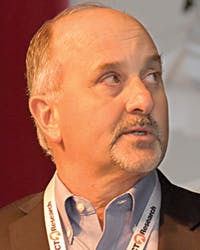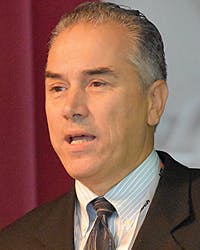Cleaner air, technologies are the ultimate goal, but approaches vary
Zero emissions is the name of the game.
The rules of engagement, however, remain unclear, with government agencies and companies across the country deploying different strategies, from regulating clean-air requirements or improving diesel technology, to Cummins’ goal of addressing every customer’s needs with electric, hybrid and cleaner-fuel powertrains.
The task, then, says Diesel Technology Forum executive director Allen Schaeffer, is for manufacturers, fleets and their communities to balance the competing demands of government, end-users and advancements.
“(Zero emissions) is one thing, but it’s not the only thing,” Schaeffer said during ACT Research’s biannual seminar in Columbus, Indiana.
“The real name of the game is now balancing the increasing dynamic and conflicting, opposing demands of the government, technology, the marketplace and the customer. That balance really is where the action is.”
Do it with diesel
Schaeffer made several points in his case for furthering diesel technology innovation, rather than abandoning it in favor of the fuel flavor of the month. It’s still the “gold standard,” especially for heavy-duty trucks and equipment, he said—and continues to improve—despite detractors predicting its demise.
Along with balancing demands, he said a balanced portfolio is critical, with a mix of investments in future fuels and tech. Electric vehicles are viable and competitive options for many applications today, including last-mile delivery and transit buses, but others, like long-haul, have no foreseeable diesel substitute.
In other words, diesel isn’t going away.
“It’s a competition, and the market should dictate where that goes,” Schaeffer said.
The former American Trucking Associations vice president isn’t a fan of government “meddling” in the fuels and technology marketplaces either, saying those efforts often go astray.
He brought up the anticipated heavy-duty truck migration from diesel to methanol in the early 1990s as one of several failed regulatory mandates in California and other parts of the country, including New York.
Diesel endures through it all because it works, he said.
The 100-year-old technology still offers the most energy-efficient internal combustion engine; it’s readily available, with extensive servicing, fueling and repair networks; it’s proven and reliable; durable and re-manufacturable; and it’s economical to use, in terms of the acquisition, operation and resale of diesel trucks.
The fuel also offers low-carbon capabilities.
Since 2007, Schaeffer said, advanced diesel engines, including in construction and agricultural equipment, locomotives and heavy-duty trucks, have virtually eliminated emissions of hazardous particulate matter, and dangerous nitrogen oxides (NOx) have been greatly reduced in new engines and equipment since 2011.
According to recent IHS Markit data, 97 percent of Class 8 commercial vehicles in the US still run on diesel, and one in three heavy-duty trucks on the road today are using the latest generation of diesel technology.
“The technology has fundamentally transformed over the last decade-plus thanks to cleaner fuel, the advanced engines and the emissions control technology we’re all familiar with,” he said.
Cummins can
Julie Furber, who heads Cummins’ electrified power business unit, is embracing every breakthrough—from her company’s latest diesel powertrains to hybrid, factory electric, fully electric and even fuel-cell electric—while doing her best to dispel the many myths surrounding the adoption of EVs and decline of diesel.
The first myth, she said, is the world’s vehicles will be 100-percent electric by 2030.
“I’m not sure that I would subscribe to that view,” Furber said.
“There are four keys (tech, regulations, infrastructure and total cost of ownership) to the adoption of electrification, and how fast or slow these drivers develop will determine the pace of adoption. And it’s different for different applications, different regions of the world, and for meeting different customers’ needs.”
Myth No. 2 is there isn’t sufficient electricity generation to power all future EV needs, and even if generation isn’t an issue, an inability to transmit enough power to support everyone’s needs is another constraint.
This she said, is partly true, but utility companies are highly motivated to embrace the electric “gold rush.” The key is using algorithms to balance the load by varying charge times to take advantage of off-peak hours.
A third myth is line-haul trucks already can travel 500 miles on a single charge of their batteries, with no weight penalty. False, Furber said.
“With today’s technology, if you want to travel 500 miles, you will probably add between 3 and 6 tons of extra weight to your vehicle, and therefore you cannot carry the weight of load you could before,” Furber said.
“And you also need a very long time to charge up that size of battery.” Finally, another, more surprising myth says EVs, which require electric generation and batteries eventually needing disposal, have a greater well-to-wheel carbon impact than internal combustion engines.
She doesn’t subscribe to that notion, saying EVs are hard to beat from an environmental perspective, but the technology isn’t fully developed—and won’t be for some time—making it cost- and weight-prohibitive.
Regulatory reach
Tony Brasil, chief of the California Air Resources Board (CARB) transportation and clean technology branch, disagrees with Schaeffer, saying government mandates and incentives are absolutely necessary, and effective.
He points to California’s progress toward a zero-emissions future while underscoring the need for far greater improvements—the state still has some of the most heavily polluted regions in the US—through further regulations.
“I think they’re working,” Brasil said. “As a matter of fact, starting in a year, no truck will be registered in the state unless they can show that it meets the requirements, so our enforcement will be more effective.”
CARB’s goal is to reduce NOx emissions from heavy-duty trucks—still the greatest contributors to emissions in the state—by 70% by 2031, with an 80% reduction from all transportation by 2050.
Reaching those goals requires planning, regulation and investment, Brasil said.
“Regulations are required to provide that certainty for the market, provide market signal, long-term goals, and get the investments made to meet the goals,” he said.
California’s efforts to reach zero emissions include truck and bus regulations; a clean air plan that calls for zero where possible, near-zero everywhere else; and the newly proposed Innovative Clean Transit regulation, which was set for a public hearing in September and a final vote within the next few months, Brasil said.
Under the proposal, large transit agencies will phase in zero-emission bus (ZEB) purchases starting in 2023 at 25 percent of annual new purchases. Brasil said a total of 655 ZEBs already are on order and approved for funding.
Other ongoing efforts to reduce emissions in California include Assembly Bill No. 739, which governs state purchases for vehicle fleets, the Clean Energy & Pollution Reduction Act (Senate Bill 350), the Low Carbon Fuel Standard, and the Hybrid and Zero Emission Truck and Bus Voucher Incentive Project (HVIP).
“We are trying to figure out where it makes most sense for the market to go, (and) set up rules to allow the market to do that,” Brasil said.
About the Author
Jason McDaniel
Jason McDaniel, based in the Houston TX area, has nearly 20 years of experience as a journalist. He spent 15 writing and editing for daily newspapers, including the Houston Chronicle, and began covering the commercial vehicle industry in 2018. He was named editor of Bulk Transporter and Refrigerated Transporter magazines in July 2020.




